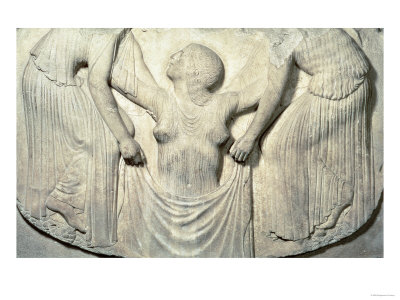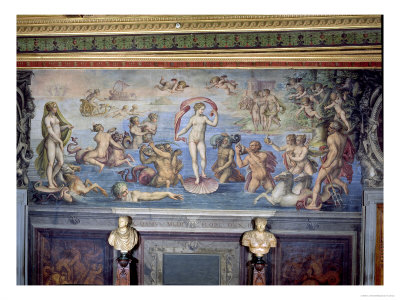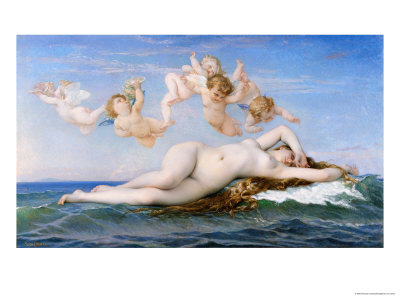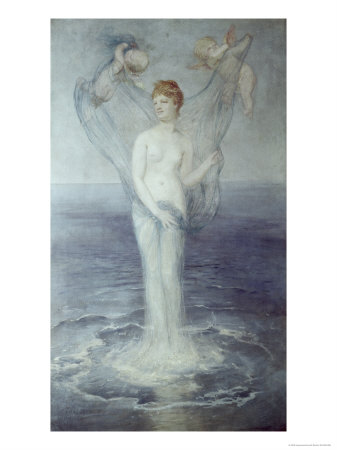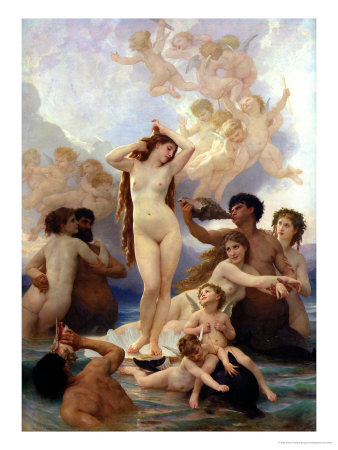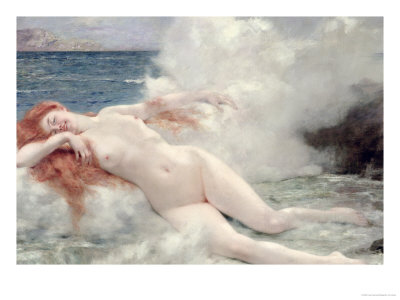Birth of Venus
The scene of the birth of Venus is one of the most represented in art. Also, in art, the Roman names of the gods were used more often, as compared to the Greek names, that's why the different paintings are not called "The birth of Aphrodite".
As you already know, Aphrodite (for the Romans: Venus), the Greek goddess of love, was born from the sea foam, when Cronus cut Uranus' genitals and threw them into the sea. The motif of the "goddess rising from the sea" was called "Venus Anadyomene". It is the subject of a well known painting from the Greek antiquity, the work of Apelles, which got lost, but it was decribed by Pliny the Elder. This painting influenced the way in which the birth of Venus was represented in art, during the centuries that followed, because many painters wanted to reproduce it, starting from the description.
While I'll try to list the paintings in a chronological order, I have to begin with maybe the most famous one: Sandro Botticelli's "Birth of Venus", from the Uffizi Gallery, in Florence, Italy. It was painted around 1484-1485 and the painter took as inspiration Angelo Poliziano's Stanze, in which the poet describes a fictitious bas-relief. Poliziano says a beautiful girl with a "nonhuman countenance", born from the sea foam, is pushed by the zephyrs to the shore, on a conch shell. On the beach, the Hours (Horae), dressed in white, wait for her and cloak her in a starry outfit, and put a crown made of gold and jewels on her head.
|
As you can see, the goddess arrives on the shores of Cyprus on a conch shell. She is an idealized representation of beauty, not a realistic woman. Even if her proportions and position are not anatomically correct (the neck is too long, the shoulders are too steep, the left hand is attached to the body in a weird way), Botticelli used these curvy lines to render his ideal of beauty.
On the goddesses' left, two winged deities blow gently, to push her to the shore. They are said to be Zephyr, the god of the west wind, and his wife, the nymph Chloris (in Poliziano's poem, she is identified as Aura, a goddess who was the personification of the breeze). They both have brown wings, and Zephyr's hair almost blends in with his wings.
On the right hand, the Hour who represents Spring waits for the goddess, with an outfit with flowers on it. All these figures are an allusion to spring, which makes flowers bloom and awakens nature to life. The lines of the characters on the left and on the right are liek two diagonal, which form a triangle which directs the eye to the center, where Venus is the focal point.
Tha painting does not have much perspective, it is almost bidimensional. The bodies are all light-weight, so as to render the spiritual elevation that love brings, when it is born.
Apart from the mythological interpretation, the painting is also an allegory for the Christian baptism, and Venus represents the soul which comes out purified from the water of the baptism. This interpretation also makes sense because it seems the painting was ordered by Lorenzo di Pierfrancesco de' Medici for the baptism of his daughter, Maria Margherita, and the shell is also an allusion to a pearl, for which the Latin word was "margarita".
An ancient bas-relief with the birth of the goddess of love, in which you can see the specific elements. Here she is dressed by two creatures of the sea.
|
*************************************************************
Another famous bas-relief is the one on the Ludovisi Throne, found in 1887. Even if many thought that it was a forgery, it seems to be a part of a temple from MArasa, near Locri, dedicated to goddess Aprhodite. It represents the goddess emergin from the sea, helped by two Horai, who hold a veil which partially covers the goddess.
|
*************************************************************
Titian represented the goddess Venus in many of his works, but only in one of them she is depicted when emerging from the water. In his Venus Anadyomene (1525), she's wringing her hair and this gaves her a sinuous position. She's probably close to the shore, because we see that water is below her hips. Near her we can see a shell, an allusion to the myth of her birth.

*************************************************************
In Palazzo Vecchio, in Florence, Italy, there is a room called Sala degli Elementi (Room of the elements), in which there is a fresco by Cristofano Gherardi and Giorgio Vasari, in which the theme of the birth of Venus was chosen for the allegory of the water.
|
*************************************************************
Another famous painting, by Jean-Auguste-Dominique Ingres, was started in 1808 and finished in 1848. His Venus Anadyomene was a model for the painters who tried their hands at this subject after him. The goddess is emerging from the foam, with little angels around her. One of them is Cupid (he holds a bow) and another angel gives her a mirror, a symbol of her beauty. Her position, with the hands raised above her head, served as inspiration in many ulterior paintings (see below).
|
*************************************************************
In Eduard Steinbruck's Birth of Venus (1846), we can see the goddes half-dressed, with the Graces and little cupids around her (I couldn't find any other information about this painting, but I think the three girls are the Graces because of the position of their hands, which is typical).
|
**************************************************
Here is another painting on the same subject, by the French painter Alexandre Cabanel. This painting was an illustration of the official taste of the second Empire. It was presented at the Salon de Paris in 1863 and it was bought by Napoleon III for his personal collection.
Cabanel represented the goddess of love laying on the waves, in the act of waking up. She protects her eyes from the light with her right hand. There are little angels above her, who form a sort of pyramid. Some of them blow in a shell.
This painting was very criticized at the time, with Emile Zola saying the goddess was "drown" in milk and had an almond-paste complexion.
|
**************************************************
In Arnold Böcklin's painting, Venus is represented as she emerges from the sea foam (you probably already noticed that, while the title is often "The birth of Venus", the paintings represent in fact the goddess floating on the conch shell or setting foot on land). Two little angels drape her in a veil which seems made of sea water.
|
**************************************************
Another famous painting with this subject is The birth of Venus by William Bouguereau (1879). Again, the goddess is the central figure of the composition. She is trying to wring her hair and this movement makes her look very sensual, without being vulgar. Everyone around her looks admiringly at her, because they have never seen such a beauty (but my favourithe character is the little boy who plays with the dolphin - and, by the way, the dolphin means the goddess is a daughter of the sea).
She is represented in the light, while all the others are in a kind of shadow. Around her there are centaurs and nymphs. Two of the centaurs blow into shells, to let the world know about the birth of the goddess.
Above her head there are many little angles or Cupids (on of them is, in fact, Cupid himself, with his bow and arrows). Their meaning is that the goddess is a gift sent from heaven to the world.
|
***************************************************************
Henri Gervex represented her as being pushed to the shore by the waves. She rests on the white foam of the waves, which looks almost as a cloud.
|
***************************************************************

Custom Search


